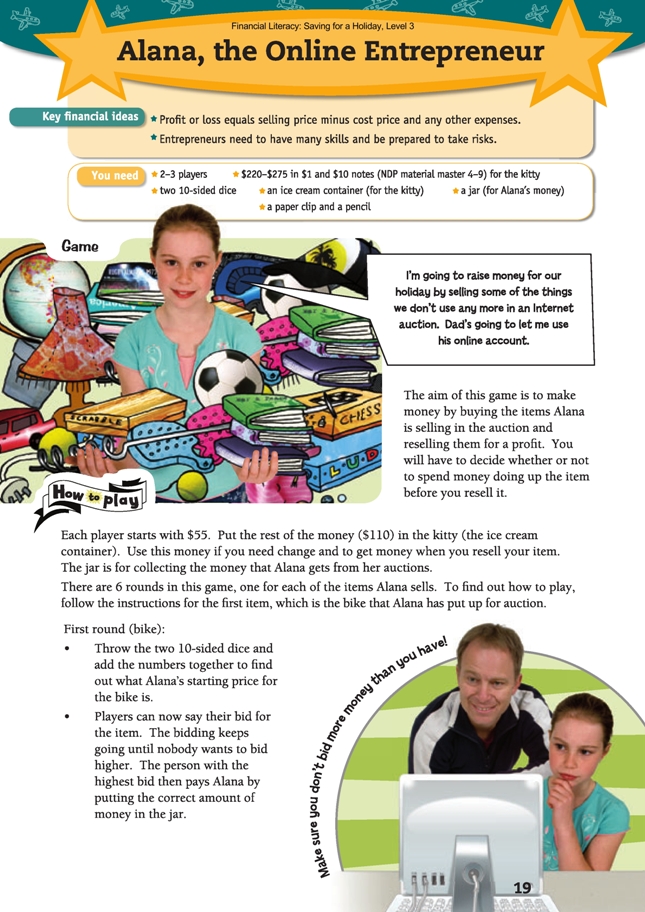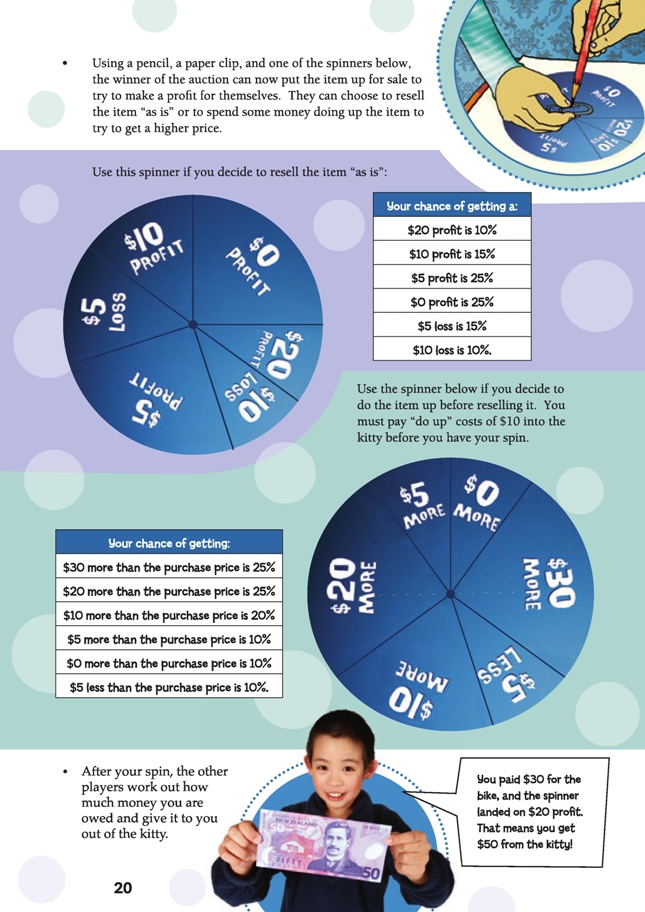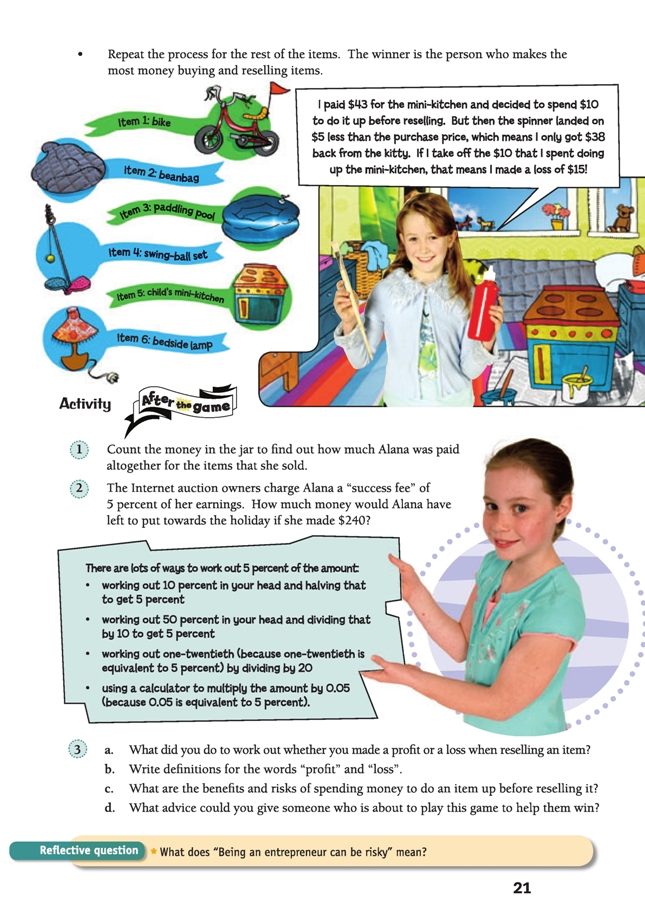This is a level 3 number and statistics activity from the Figure It Out series. It relates to Stage 6 of the Number Framework.
A PDF of the student activity is included.
Click on the image to enlarge it. Click again to close. Download PDF (3758 KB)
use addition and subtraction to solve money problems
compare probability chances
Number Framework Links
These pages involve adding and subtracting 2-digit whole numbers and finding 5 percent of an amount.
Students working at stage 6 should be able to do the mathematical calculations in the game mentally. Students working at stages 4 and 5 should also be able to do the calculations but may need the support of materials such as tens money.
Students at stage 7 should be able to do question 2 in the activity using mental strategies. (See the table of NDP material on page 4.)
$220 - $275 in $1 and $10 nots for the kitty (see Related Resources)
Two 10-sided dice
An ice cream container (for the kitty)
FIO, Level 3, Financial Literacy: Saving for a Holiday, Alana the Online Entrepreneur, pages 19-21
A jar (for Alana's money)
A paper clip and a pencil
Game
Financial understanding
This game simulates earning profits in auctions by buying and reselling items and enables the students to explore what it means to be an entrepreneur. (An entrepreneurial person has a skill set that sets them apart. These skills are not just financial; they include all the enterprising processes and attributes.) However, the students will also quickly learn that along with the benefits of this behaviour, there are a number of risks. Risk needs to be considered before making a financial decision.
Successful people identify risks before embarking on a project or making a decision. Students will engage in identifying, assessing, and managing risks during the game as they weigh up the value of an item and determine whether they can make a profit from it.
If the students use two packs of playing cards instead of tens money in the game, the picture cards are worth $10, the ace $1, and the number cards are worth their face value. Each player gets $55 to start with, made up of ace, 2, 3, 4, … 10 in a single suit. The rest of the cards go in the kitty. If you don’t have 10-sided dice, normal
6-sided ones are fine, although the students may end up with slightly lower starting prices.
Introduce the game by asking if any students have been to an auction or if their family has bought items in an online auction. Ask them to describe what happens. Then ask:
Why might people choose to auction off something instead of just setting a price themselves? (They may not be sure of how much to ask, so they want to “let the market speak”, or they may think that they can get a higher price in an auction because people will compete against each other to buy the item.)
Why might some people pay more in an auction than they would if there was just a price tag on the item? (The excitement and competitive nature of the bidding process might make them bid more than they had planned to because they might think, “If I just bid another $2, I might win!”)
You could demonstrate the first round of the game with the whole class so that they get the idea of the procedure. If you do this, you could summarise the process on the board:
1. Throw the dice to find the starting price.
2. Bid and see who wins the auction; the winner pays Alana.
3. Decide if you will resell the item “as is” or if you will pay $10 to do it up.
4. Spin and get the money you are owed from the kitty.
Encourage everyone in the group to work out the amount owed to the player, to “make sure they are correct”, so that they are all involved in the mathematical thinking for each round.
Activity
Financial understanding
In this post-game activity, the students define profit and loss and learn how to calculate figures to get a financial result. The activity emphasises that a profit is a desirable outcome from any business transaction. People need to be accountable for their financial decisions, and having a sound understanding of the financial concepts is an important part of that and of accepting the need to be financially responsible.
Mathematics and statistics
In question 2, students at stage 6 or below may need support to work out 5 percent of an amount. To use the strategies suggested in Alana’s hint box, students need to understand that:
1. You can find a benchmark that’s easy to calculate mentally, like 10 percent or 50 percent of the amount, and manipulate that to work out 5 percent of the amount. For example, for 5 percent of $45 =: 10 percent of $45 is $4.50 ($45 ÷ 10 = $4.50); 5 percent is half as much as 10 percent, so to work out 5 percent of $45, we can halve $4.50. $4.50 ÷ 2 = $2.25 or:
50 percent of $45 is $22.50 ($45 ÷ 2 = $22.50); 5 percent is 1 tenth of 50 percent, so to work out 5 percent of $45, we can divide $22.50 by 10. $22.50 ÷ 10 = $2.25.
2. If you know that 5 percent and one-twentieth are equivalent, you can work out one-twentieth of $45 instead. You may have to make some proportional adjustments to make the calculation easier. So, for $45 ÷ 20 = : halving both makes the calculation easier in this case, but gives the same answer: $22.50 ÷ 10 = $2.25.
3. If you are using a calculator to work out 5 percent of $45, you can use the % button and key in “45 x 5%”, or if you know that 5 percent is equivalent to the decimal fraction 0.05, you can key in “0.05 x 45 =”.
Extension
Financial understanding
As a follow-up, you could discuss:
Which enterprising processes and attributes did Alana show?
What risks did you have to take when playing this game? Did they pay off financially for you?
What have you learned from playing this game that might be useful if you ever use a real online auction to buy and sell?
Social Sciences Links
Achievement objectives:
• Understand how groups make and implement rules and laws (Social Studies, level 3)
• Understand how people make decisions about access to and use of resources (Social Studies, level 3)
Students could examine the difference between wholesale and retail and the role of the “middle person”. They could investigate and perhaps visit real auctions, for example, the wholesale flower markets, cattle markets, or property auctions, or investigate online auctions. They could interview an auctioneer using questions they
have generated themselves.
An interesting side exploration could be into the art of haggling, where each buyer negotiates their own price with the seller. Ask: What is haggling? How does it work? What are the advantages and disadvantages of haggling compared to having a fixed price tag? Travel guides to countries that use haggling in everyday transactions are useful sources of information (for example, many Middle Eastern countries).
Another side exploration could be into bartering, when goods or services are exchanged without using money. Students could investigate the “green dollar”.
Get the students to interview a local entrepreneur, for example, a small business owner, and ask them to talk about how they have demonstrated some of the enterprising attributes, such as generating, identifying, and assessing opportunities, or identifying, solving, and preventing problems.
Other Cross-curricular Links
Technology achievement objective:
• Outcome development and evaluation: Investigate a context to develop ideas for potential outcomes. Trial and evaluate these against key attributes to select and develop an outcome to address the need or opportunity. Evaluate this outcome against the key attributes and how it addresses the need or opportunity
(Technological Practice, level 3)
Students could become entrepreneurs themselves by identifying a need and developing a technological outcome that could be marketed. You could hold your own class auction with goods that the students have made (food items, jewellery, craft items, cards, and so on) or services that they can provide each other (being
a desk tidier, doing someone else’s monitor jobs for a day, teaching a soccer skill, giving someone batting practice, and so on). Invent a class currency that they can earn during the week and then use for the auction on Friday.
Answers to Activity
Game
A game involving online auctions and profit and loss
Activity
1. Answers will vary each time this game is played.
2. $228. (See page in students’ book for various methods of working out 5%. $240 – $12 [5%] = $228)
3. a. Answers will vary. One way to calculate whether you have made a profit or a loss is to compare the money you paid Alana to the money you were paid after you spun the spinner. Remember to deduct the $10 “do up” costs from your profit if you
decided to do up the item before selling it.
b. Wording will vary. Profit: the amount of income you have left after deducting all
your costs. Loss: the amount by which your costs are higher than your income.
c. Answers will vary. Ideas might include: benefits: you might make more profit
because people might be willing to pay a higher price, which might be more than
it cost you to do up the item; risks: you might not get back what it cost
you to buy and do the item up, and you’ve spent more money on it, so your loss would be greater.
d. Answers will vary.
Reflective question
Answers will vary. Entrepreneurs can make a lot of money, but they can also lose a lot of money if their ideas don’t work, someone else starts selling a similar product before they’re ready to sell theirs, or people lose interest in the activity the entrepreneur has invested a lot of money in.


